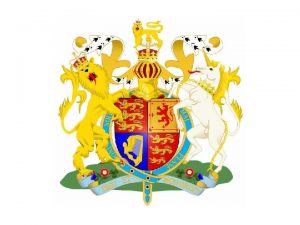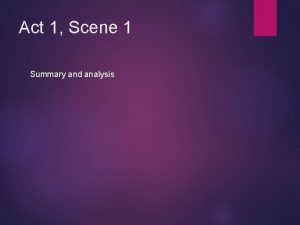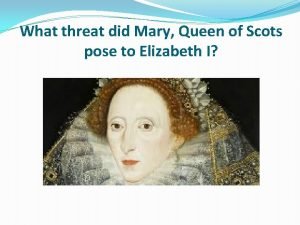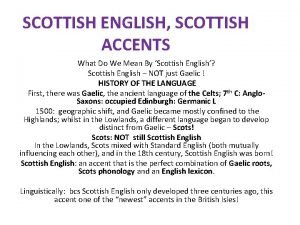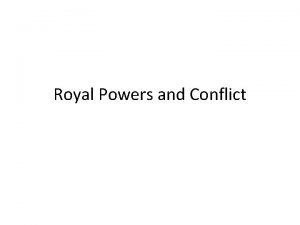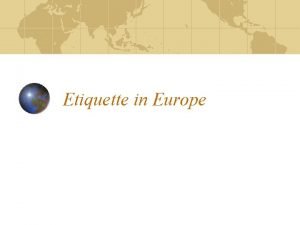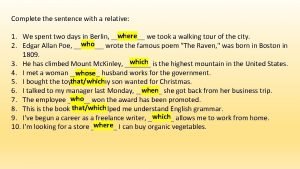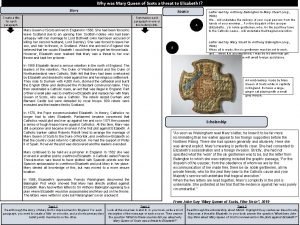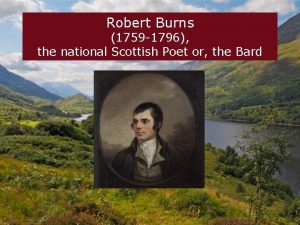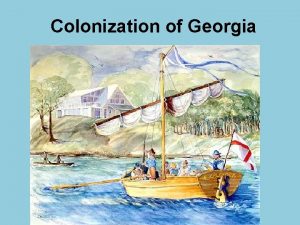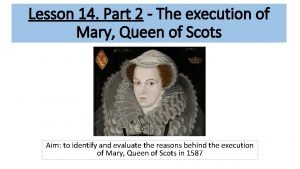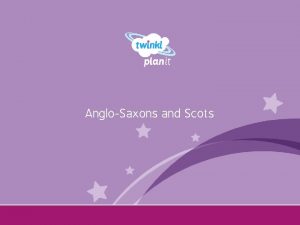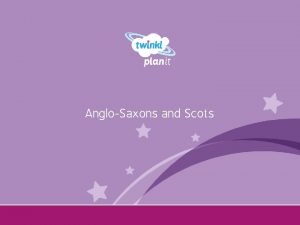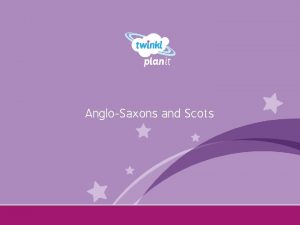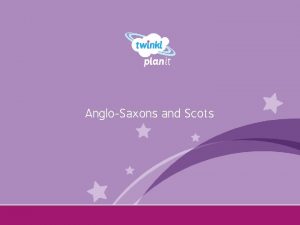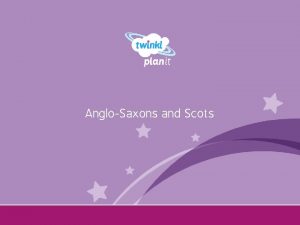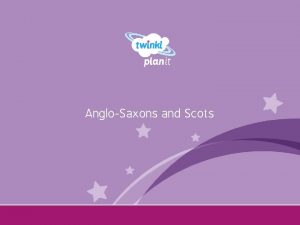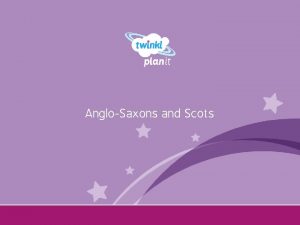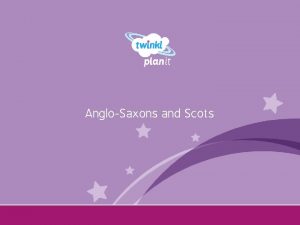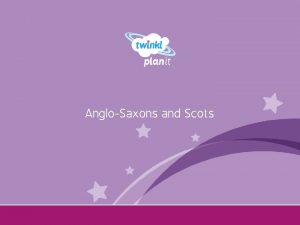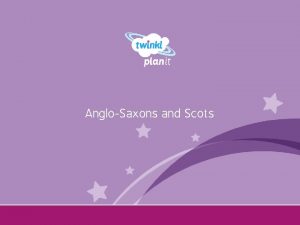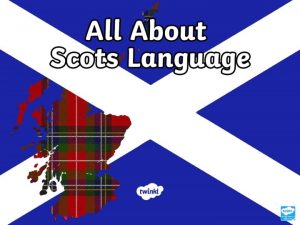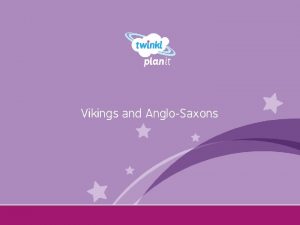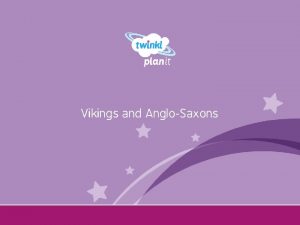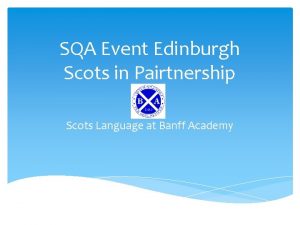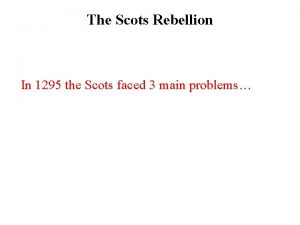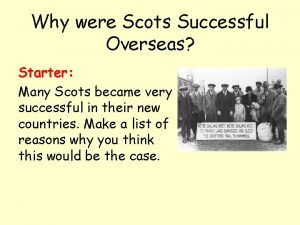AngloSaxons and Scots Year One I can explain





















- Slides: 21

Anglo-Saxons and Scots Year One


• I can explain the religious beliefs and practices of the early Anglo Saxon people and I know and can describe some of the gods they worshipped. • I can identify true facts about Anglo Saxon religious beliefs and practices and use these to ask and answer my own questions. • I can use my knowledge and imagination to describe an Anglo Saxon god in detail.

Read these statements about Anglo Saxon religion. Discuss with your partner which you think are true and which you think are false and your reasons for believing so. Be ready to feed your ideas back to the rest of the class. 1. The Anglo Saxons were Pagan when they first came to Britain. 2. The Anglo Saxons believed in many gods. 3. The Anglo Saxons believed that magic spells and lucky charms would protect them. 4. The Anglo Saxons thought that burning down crops would keep ghosts away. 5. The Anglo Saxons believed in dragons and elves.

The religion of the early Anglo Saxon people was Paganism is a polytheistic religion, which means many gods are worshipped.

There were many Anglo Saxon festivals throughout the year. During the festivals different gods were worshipped. The people would pray to the gods and make sacrifices of objects and animals. It is believed that bonfires were common during the festivals and that people would dance around or over them and throw herbs and other offerings into the flames. Why do you think the Anglo Saxon people made sacrifices to the gods?

Most of what we know about the Anglo Saxon festivals comes from a book called De Temporum Ratione (which mean The Reckoning of Time). It was written by a Christian monk called Bede in 725 AD. In the book the Venerable Bede describes the Anglo Saxon calendar and details of the different festivals that were held in the months throughout the year. What festivals do you celebrate each year?

Bede said that this was the main Pagan festival which was celebrated on the winter solstice (around the 25 th December) each year. It marked the start of the Anglo Saxon year. During the festival Bede reports that the Anglo Saxons would have a big feast, decorate their villages and houses with evergreen branches and burn a yule log. What Christian festival does this remind you of?

The most important spring festival was held during Eostremonath (April). During this festival the goddess Eostre was worshipped and people gave eggs as gifts. The festival celebrates rebirth and marks out the start of the warmer months. What Christian festival does this remind you of?

Blodmonath was the Anglo Saxon month of November. It means ‘blood month’ or ‘month of sacrifice’. During the festival of Blodmonath, people made offerings to the gods by sacrificing their animals. Why do you think the Anglo Saxons sacrificed their animals during the Blodmonath festival?

The Anglo Saxon people were very superstitious. They believed in good and bad omens, lucky charms, spells and magic as they thought that these things could influence what happened in different aspects of their lives. The Anglo Saxons performed many rituals that they believed would protect them in this life and the next. This was especially true about the way they dealt with the dead. It was common to bury a person with their belongings as the Anglo Saxons believed the dead person would need these in the afterlife. Some people were even buried with a slave or pet!

Work with a partner to make a list or poster detailing 5 facts about the Anglo Saxon Pagan religion. • Include as much detail as you can. • You can include pictures to illustrate your facts as well. • Use the pictures on this slide to help you remember the facts.

The Anglo Saxons believed in lots of different gods who they believed represented and were responsible for different things. The people prayed to the gods in hope that they would offer protection or provide them with the things they needed. Today we are going to learn about some of the main Anglo Saxon gods.

• Woden was the chief of the Anglo Saxon gods. • He was the god of battle and war. • Woden was also believed to be the observer of humans and the Anglo Saxons thought he may visit them in disguise. • His special animal was the wolf and he had two wolves as pets. • His special object was a spear. • The day of the week Wednesday was named after him.

• Frigg was the wife of Woden. • She was the goddess of the household and childbirth and people would pray to her to ask for a good birth. • Her name means ‘beloved’. • Her symbols are the stork and the spinning wheel. • The day of the week Friday is named after her.

• Thunor was the god of thunder. He is also known as Thor. • Thunor was known as the protector of humans against threats. • He has a hammer as his symbol. • Goats are his special animal as they were believed to pull his chariot. • Thunor was the son of Woden and Frigg. • The day of the week Thursday is named after him.

• Tiw is another god of war. • He is associated with being courageous and making sacrifices in battle. • His special animal is the wolf. • He is often shown with only one hand, as legend says a wolf bit off the other one. • The day of the week Tuesday is named after him.

• Eostre was the goddess who was worshipped during Eostremonath (April). • Eostremonath is associated with rebirth and the giving of eggs. • Her symbol is the hare. • People would pray to Eostre to ask for good fortune in the coming summer months. • It is thought that Pagans offered hot cross buns to Eostre during Eostremonath and the four quarters represented the quarters of the moon.

Can you write a quiz about Anglo Saxon religion and gods?

• I can explain the religious beliefs and practices of the early Anglo Saxon people and I know and can describe some of the gods they worshipped. • I can identify true facts about Anglo Saxon religious beliefs and practices and use these to ask and answer my own questions. • I can use my knowledge and imagination to describe an Anglo Saxon god in detail.

 Angles in scotland
Angles in scotland In what year is act one, scene one set?
In what year is act one, scene one set? How did queen elizabeth 1 die
How did queen elizabeth 1 die Scottish english features
Scottish english features Mary stuart death mask
Mary stuart death mask Scots vs english
Scots vs english Then we visited a lake. it is in the highlands
Then we visited a lake. it is in the highlands The magic pizza scots poem
The magic pizza scots poem Triple entente
Triple entente Mary queen of scots cat embroidery
Mary queen of scots cat embroidery Sqa scots language
Sqa scots language Scots wha hae translation
Scots wha hae translation Highland scots impact on georgia
Highland scots impact on georgia Mary queen of scots execution lesson
Mary queen of scots execution lesson Structure of twelfth night
Structure of twelfth night Poem for leaving primary school
Poem for leaving primary school One god one empire one religion
One god one empire one religion One one one little dog run
One one one little dog run One king one law one faith
One king one law one faith Byzantine definition
Byzantine definition One team one plan one goal
One team one plan one goal See one do one teach one
See one do one teach one
